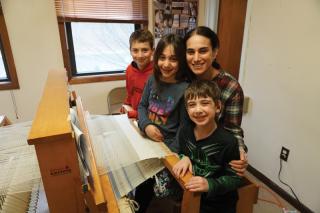
By Bethany Kandel
While every Bar Mitzvah boy and Bat Mitzvah girl may wear a tallit during services, the pieces of cloth are all unique.
Wrapping oneself in a shawl during prayer or reading from the Torah is meant to aid in attaining a proper mood of reverence for God. Made of silk, cotton, wool, or synthetics, a tallit can be plain and simple, or highly adorned. What transforms it from a mere piece of cloth into a tallit are the tzizit, the specially knotted fringes on the four corners, which are to remind us of the commandments of the Torah.
The tallit a young boy or girl wears for their Bar or Bat Mitzvah, can have great significance. Some are passed along from generation to generation. Others are bought on a trip to Israel. And now, many young people are choosing to either make or design their own, to add personal and truly unique meaning and expression to the symbolic garment.
Do you love the color purple? Design one in all its gorgeous shades. Why not weave in the names of your beloved late grandparents? Or how about including a whole family tree? When you design your own tallit, the sky is the limit. Here are some ways to create your own:
Weaving At The Loom Room
For the past four years, the Loom Room founded by the sisterhood at Neve Shalom Synagogue in Metuchen, NJ, has been a hub of activity and creativity. Hundreds of tallitot have come off the loom with colors that represent the rainbow, as well as the traditional blue and white stripe.
“It’s a priceless experience for the whole family to create a custom tallit,” explains Cory Schneider, founder of the Loom Room. Not only are they creating a one-of-a-kind family heirloom, but “It’s a journey they do together. It creates powerful memories. You don’t get that when you buy a tallit in the store.”
Laurie Solomon recently completed tallitot for each of her two young sons and a challah cover for her daughter there. The entire family took part in the weaving process, from the 93-year-old great-grandmother, to the youngest 6-year-old son. Why do it now, when her sons are only 10 and 6? “To make sure all the generations were around to participate,” says Solomon.
“I was never a weaver; I had no idea what I was getting into,” she adds. But over the months of work, she became very proficient. Now that the projects are complete, she’s excited for them to be worn by her sons in the future. “It’s something so meaningful and they’ll have forever. I hope they’ll remember the love and work that went into making them, and always think of us when they wear them; even we’re no longer around.”





Make Your Own
“I want the tallit to be a work of art,” says New York textile artist Susan Schorr. She works with students at West End Synagogue to design, dye, and paint on silk, sometimes using an ice-dye method. For kids who are vegetarians, or especially environmentally aware, she offers fabric made out of bamboo, pineapple leaves, cruelty-free silk, and even from recycled soda bottles.
Before starting the process, she encourages the kids to go through a design process and play with color until they find something they love. “I remind them to think to the future,” she says. “Some designs might be great for a 12-year-old, but they aren’t going to want to wear them at 17. They all want something they are going to be proud of.”
Some students incorporate photos, embroidery, and other embellishments. They often want to print quotes, including the traditional blessing. “I had one student who wanted to use the quote ‘Man plans; God laughs.’ The parents weren’t too happy about it, until they discovered that it was the quote the grandfather had used in his law school yearbook. Then they loved it.”
She encourages all the family members to get involved in tying the tzizit to make it even more special.





One-of-a-Kind Creativity
When Maxine Feldman was planning her son’s Bar Mitzvah 15 years ago, she wanted to do something creative for him. So, the New York City printmaker designed a tallit in his favorite colors, green and yellow.
She collaborated with a quilter from Ashland, OR, to complete the project. When people kept asking where she got his tallit, a business was born. Now Feldman works with local students to create custom tallitot out of raw silk. She hand-paints the four corners and a colorful stripe down the middle or a piece to go underthe atara. She can also make a matching pouch.
“I ask them what colors they like; what color combinations,” she says. “They love playing around with swatches and choosing color schemes. They want to be a part of the process instead of going to the store and just picking out a premade one. These are special and they’ll last a lifetime.”





Resources to create or commission your own hand-crafted tallit:
• Susan Schorr: To learn about classes or commission a tallit contact, [email protected]
• Maxine Feldman: Find out how to commission a handmade tallit by emailing, [email protected]
• For information about the Neve Shalom Loom Room, contact Cory Schneider, 717-574-1807, or email [email protected], neveshalom.net/sisterhood
• There is also a loom room at the JCC of Wyoming Valley in Wilkes-Barre, PA, 570-824-4656, ext. 237, jewishwilkes-barre.org/activities/programming/tallis-weaving-at-the-jcc
• Pennsylvania Rabbi Rayzel Raphael makes personalized silk-painted tallit and offers workshops where you can make your own. 215-782-1221, shechinah.com/shechinah-silks.html
• The Tallis Lady sells hundreds of varieties of handmade tallitot, plus tallit clips, beaded and crocheted kippot, and more. 201-321-4995, thetallislady.com
• Artist Jan Lichtenstein’s work can be seen at itsbyjan.com. Contact her to commission a tallit, [email protected].
• Etsy: Many artists on etsy.com sell all types of customized tallit.
 Get your FREE copy here.
Get your FREE copy here.





